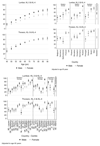Degenerative inter-vertebral disc disease osteochondrosis intervertebralis in Europe: prevalence, geographic variation and radiological correlates in men and women aged 50 and over
- PMID: 28398504
- PMCID: PMC5582627
- DOI: 10.1093/rheumatology/kex040
Degenerative inter-vertebral disc disease osteochondrosis intervertebralis in Europe: prevalence, geographic variation and radiological correlates in men and women aged 50 and over
Abstract
Objectives: To assess the prevalences across Europe of radiological indices of degenerative inter-vertebral disc disease (DDD); and to quantify their associations with, age, sex, physical anthropometry, areal BMD (aBMD) and change in aBMD with time.
Methods: In the population-based European Prospective Osteoporosis Study, 27 age-stratified samples of men and women from across the continent aged 50+ years had standardized lateral radiographs of the lumbar and thoracic spine to evaluate the severity of DDD, using the Kellgren-Lawrence (KL) scale. Measurements of anterior, mid-body and posterior vertebral heights on all assessed vertebrae from T4 to L4 were used to generate indices of end-plate curvature.
Results: Images from 10 132 participants (56% female, mean age 63.9 years) passed quality checks. Overall, 47% of men and women had DDD grade 3 or more in the lumbar spine and 36% in both thoracic and lumbar spine. Risk ratios for DDD grades 3 and 4, adjusted for age and anthropometric determinants, varied across a three-fold range between centres, yet prevalences were highly correlated in men and women. DDD was associated with flattened, non-ovoid inter-vertebral disc spaces. KL grade 4 and loss of inter-vertebral disc space were associated with higher spine aBMD.
Conclusion: KL grades 3 and 4 are often used clinically to categorize radiological DDD. Highly variable European prevalences of radiologically defined DDD grades 3+ along with the large effects of age may have growing and geographically unequal health and economic impacts as the population ages. These data encourage further studies of potential genetic and environmental causes.
Keywords: Kellgren–Lawrence grading; age range 50 plus years; bone mineral density (BMD); degenerative disease; intervertebral disc; multi-centre prevalence study; osteochondrosis intervertebralis; plane radiology; population-based; reproducibility study.
© The Author 2017. Published by Oxford University Press on behalf of the British Society for Rheumatology. All rights reserved. For Permissions, please email: journals.permissions@oup.com
Conflict of interest statement
Gabriele Armbrecht MD, Dieter Felsenberg MD, Melanie Ganswindt MD, Mark Lunt PhD, Stephen K Kaptoge PhD, Klaus Abendroth MD, Antonio Aroso Dias MD, Ashok K Bhalla MD, Jorge Cannata Andia MD, Jan Dequeker MD, Richard Eastell MD, Krysztoff Hoszowski MD, George Lyritis MD, Pavol Masaryk MD, Joyce van Meurs PhD, Tomasz Miazgowski MD, Ranuccio Nuti MD, Gyula Poor MD, Inga Redlund-Johnell MD, David M Reid MD, Helmut Schatz MD, Christopher J Todd PhD, Anthony D Woolf MD, Fernando Rivadeneira MD, Muhammed K Javaid MD, Cyrus Cooper MD, Alan J Silman MD, Terence W O’Neill MD and Jonathan Reeve DM all declare that they have no conflict of interest.
No commercial organization financed this study.
Figures




Similar articles
-
Vertebral Scheuermann's disease in Europe: prevalence, geographic variation and radiological correlates in men and women aged 50 and over.Osteoporos Int. 2015 Oct;26(10):2509-19. doi: 10.1007/s00198-015-3170-6. Epub 2015 May 29. Osteoporos Int. 2015. PMID: 26021761
-
Lumbar disc degeneration in osteoporotic men: prevalence and assessment of the relation with presence of vertebral fracture.J Rheumatol. 2013 Jul;40(7):1183-90. doi: 10.3899/jrheum.120769. Epub 2013 Jun 1. J Rheumatol. 2013. PMID: 23729808
-
Older men with severe disc degeneration have more incident vertebral fractures-the prospective MINOS cohort study.Rheumatology (Oxford). 2017 Jan;56(1):37-45. doi: 10.1093/rheumatology/kew327. Epub 2016 Oct 3. Rheumatology (Oxford). 2017. PMID: 27703044
-
Radiographic features of lumbar disc degeneration and bone mineral density in men and women.Ann Rheum Dis. 2006 Feb;65(2):234-8. doi: 10.1136/ard.2005.038224. Epub 2005 Jul 13. Ann Rheum Dis. 2006. PMID: 16014671 Free PMC article.
-
Degenerative lumbar spondylolisthesis: cohort of 670 patients, and proposal of a new classification.Orthop Traumatol Surg Res. 2014 Oct;100(6 Suppl):S311-5. doi: 10.1016/j.otsr.2014.07.006. Epub 2014 Sep 5. Orthop Traumatol Surg Res. 2014. PMID: 25201282 Review.
Cited by
-
Alteration of Relative Rates of Biodegradation and Regeneration of Cervical Spine Cartilage through the Restoration of Arterial Blood Flow Access to Rhomboid Fossa: A Hypothesis.Polymers (Basel). 2021 Dec 3;13(23):4248. doi: 10.3390/polym13234248. Polymers (Basel). 2021. PMID: 34883749 Free PMC article.
-
Kartogenin-enhanced dynamic hydrogel ameliorates intervertebral disc degeneration via restoration of local redox homeostasis.J Orthop Translat. 2023 Jul 31;42:15-30. doi: 10.1016/j.jot.2023.07.002. eCollection 2023 Sep. J Orthop Translat. 2023. PMID: 37560412 Free PMC article.
-
Polygenic height prediction for the Han Chinese in Taiwan.NPJ Genom Med. 2025 Feb 5;10(1):7. doi: 10.1038/s41525-025-00468-6. NPJ Genom Med. 2025. PMID: 39910149 Free PMC article.
-
The correlation between osteoporotic vertebrae fracture risk and bone mineral density measured by quantitative computed tomography and dual energy X-ray absorptiometry: a systematic review and meta-analysis.Eur Spine J. 2023 Nov;32(11):3875-3884. doi: 10.1007/s00586-023-07917-9. Epub 2023 Sep 23. Eur Spine J. 2023. PMID: 37740786
-
What Is the Functional Spinopelvic Relationship in Three Dimensions? A CT and EOS Study.Clin Orthop Relat Res. 2025 Mar 28;483(7):1349-1359. doi: 10.1097/CORR.0000000000003473. Clin Orthop Relat Res. 2025. PMID: 40145814
References
-
- Muraki S, Oka H, Akune T, Mabuchi A, En-Yo Y, Yoshida M, et al. Prevalence of radiographic lumbar spondylosis and its association with low back pain in elderly subjects of population-based cohorts: the ROAD study. Ann Rheum Dis. 2009;68(9):1401–1406. - PubMed
-
- Spector TD, MacGregor AJ. Risk factors for osteoarthritis: genetics. Osteoarthritis Cartilage. 2004;12(Suppl A):39–44. - PubMed
Publication types
MeSH terms
Grants and funding
LinkOut - more resources
Full Text Sources
Other Literature Sources
Medical
Research Materials

